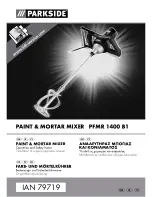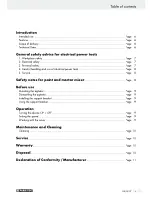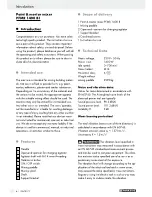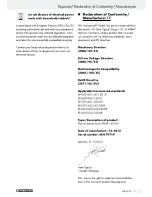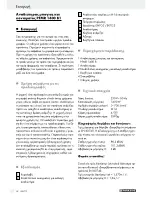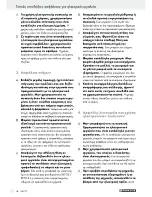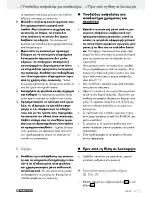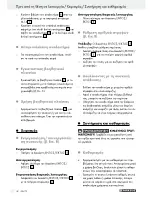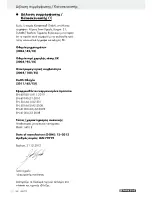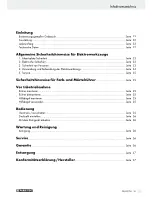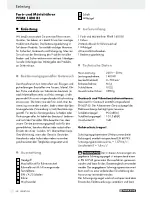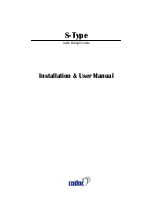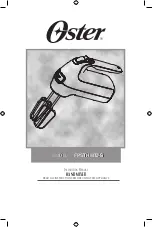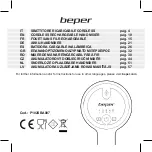
7
GB/IE/CY
Introduction / General safety advice for electrical power tools
Introduction
Note:
If you wish to make an accurate assessment
of the vibration loads experienced during a particular
period of work, you should also take into account
the intervening periods of time when the device is
switched off or is running but is not actually in use.
This can result in a much lower vibration load over
the whole of the work period.
General safety advice for
electrical power tools
Please read all
safety information and instructions.
Failure to observe the safety information
and instructions can result in electric shock, fire
and / or serious injury.
For future reference keep all the safety
advice and instructions in a safe place.
The term “electrical tool” used in the safety advice
refers to electrical tools powered by mains electric-
ity (by means of a mains lead) and electrical tools
powered by rechargeable batteries (without a mains
lead).
1. Workplace safety
a)
Keep your working area clean and
well lit.
Untidy or poorly lit working areas
can lead to accidents.
b)
Do not work with the device in poten-
tially explosive environments, which
contain inflammable liquids, gases or
dusts.
Electrical power tools create sparks,
which can ignite dusts or fumes.
c)
Keep children and other people away
while you are operating the electrical
tool.
Distractions can cause you to lose control
of the device.
2. Electrical safety
a)
The mains plug on the device must match
the mains socket. The plug must not be
modified in any way. Do not use an
adapter plug with devices fitted with
a protective earth.
Unmodified plugs and
matching sockets reduce the risk of electric shock.
b)
Avoid touching grounded surfaces
such as pipes, radiators, ovens, and
refrigerators.
There is an increased risk of
electric shock if your body is earthed.
c)
Keep the device away from rain or
moisture.
The penetration of water into the elec-
trical device increases the risk of an electric shock.
d)
Do not use the mains lead for any pur-
pose for which it was not intended, e.g.
to carry the device, to hang up the de-
vice or to pull the mains plug out of the
mains socket. Keep the mains lead away
from heat, oil, sharp edges or moving
parts of the device.
Damaged or tangled
cables increase the risk of an electric shock.
e)
If you are working outdoors with an
electrical power tool, always use ex-
tension cords that are approved for
outdoor use.
The use of an extension cable
suitable for outdoor use reduces the risk of
electric shock.
f)
Use a residual current device (RCD) for
protection if the operation of the elec-
trical power tool in a moist environment
cannot be avoided.
The use of an RCD re-
duces the risk of electric shock.
3. Personal safety
a)
Remain alert at all times, watch what
you are doing and always proceed
with caution. Do not use the device if
you are tired or under the influence of
drugs, alcohol or medication.
One moment
of carelessness when using the device can lead
to serious injury.
b)
Wear personal protective equipment
and always wear safety glasses.
The
wearing of personal protective equipment such
as dust masks, non-slip safety shoes, safety hel-
mets or ear protectors, appropriate to the type
of electrical power tool used and work under-
taken, reduces the risk of injury.
Summary of Contents for PFMR 1400 B1
Page 3: ...5 3 4 1 2 7 B 5 4 7 C A 2 6 2 6a 6b...
Page 4: ......
Page 12: ...12...
Page 13: ...13 GR CY E 14 14 14 14 1 15 2 15 3 16 4 16 5 17 17 17 18 18 18 18 18 18 18 19 19 19 20...
Page 15: ...15 GR CY EN 60745 Q a 1 2 E...
Page 16: ...16 GR CY 3 4...
Page 17: ...17 GR CY 5 21 C 85dB A A 6a 6b...

